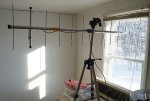While I'm certainly not an expert on antenna design and related fields, let's see if I can answer those with a laymen's background of using antennas of all kinds for a few decades.

1) Sure, because radio waves do tend to penetrate structures to varying degrees. The 450-470 MHz range should offer excellent penetration as long as you're not buried a few hundred feet inside the Pentagon or something and I doubt that's the case here. Placing it a near an unobstructed window facing the direction you want to pull in signals from would be the best for an inside situation; obviously outside facing such a direction totally unobstructed is the overall best but it should work just fine from an inside setup.
2) Roughly the same given the proximity to the actual design of the Yagi, give or take a decibel or two. I would guess (again, not an expert here) that something within 50 MHz on either side (so down to 400 MHz and potentially up to the 512 MHz range limit here in the US for UHF-Lo) would be picked up with that antenna without any major issues and a decibel or two at most.
3) In this example the vertical beam-width is like a "cone" you could create by drawing a 34 degree angle (so 17 degrees off the center axis of the beam itself on the positive and negative sides) in the direction the Yagi is facing and taking into consideration that the Yagi is a polarized antenna meaning you mount it to match the polarization of the antenna producing the signals you want to receive. Since it's a safe bet the transmitter sites for the signals you want will use vertical polarization (meaning the antenna is straight up/down and not laid flat on the horizontal) then the Yagi would also work best with the same up/down (the elements themselves) mounting position. Signals outside of that "cone" will tend to get less sensitivity and be weaker than anything that falls inside that cone which is where the directionality of a Yagi comes into play: it focuses things instead of just pulling signals in an omnidirectional sense (which is actually does but with far less sensitivity for anything "off beam" you could say.
4) There
more than likely in most situations won't be any noticeable difference between 10.2 dB and 12.25 dB overall - obviously from a purely technical standpoint there
is a ~2 dB difference, and since a difference of 3 dB equals a 2x (doubling) increase in signal levels/power then in some rare instances it could actually prove helpful but, for the most part that kind of setup won't do all that much in terms of really making a signal come in booming (with a 12.25 dB gain) vs a much different lower quality signal (with a 10.2 dB gain). Basically they're so close to each other at that level of gain any appreciable or noticeable difference won't exist. Now, a 2 dB gain vs a 10.2 or 12.25 dB gain
would absolutely be noticeable, absolutely, but since they're already quite high gain levels it's almost a diminishing returns kind of situation.
So, if you can get the 10.2 dB variant of the antenna and save a few bucks, that would be my advice, it could be something as simple as having one less element (the number of elements on a Yagi is what affects the gain, more elements = more gain as the theory goes) but again, there's a point of diminishing returns and also a higher cost for that higher gain that might not - in real world usage - actually provide a significant or cost-effective improvement in the reception quality.
Hope this helps, and I'm sure if a much more experienced person comes along and feels I haven't been thorough enough or just flat out wrong in some respects we'll find out soon enough.



